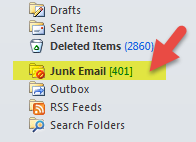Know what spam sounds like
 Spam filters check the entire content of your message and detect certain factors, phrases, and wording they regard as spam and then score your email. The filters analysis is largely based on what others have identified as spam in the past. If your message reads too much like previously identified spam mail, they will mark it as spam as well. So how does spam exactly sound? Think about all the phrases all those emails you move to your junk mail contain. Talking about large sums of money, including words like 'free' or using 'dollar signs' in your subject line, excessive use of exclamation points, all are indicators of what is considered a possible spam message. SpamAssassin, a mail filter used to identify spam shared a sample set of criteria that if found in your email results in a higher spam score:
Spam filters check the entire content of your message and detect certain factors, phrases, and wording they regard as spam and then score your email. The filters analysis is largely based on what others have identified as spam in the past. If your message reads too much like previously identified spam mail, they will mark it as spam as well. So how does spam exactly sound? Think about all the phrases all those emails you move to your junk mail contain. Talking about large sums of money, including words like 'free' or using 'dollar signs' in your subject line, excessive use of exclamation points, all are indicators of what is considered a possible spam message. SpamAssassin, a mail filter used to identify spam shared a sample set of criteria that if found in your email results in a higher spam score:- Money back guarantee (2.051 points)
- Contains urgent matter (.288 points)
- Talks about lots of money (.193 points)
- Describes some sort of breakthrough (.232 points)
- Looks like a mortgage pitch (.297 points)
Know what spam looks like
Your words aren’t the only thing that gets your messages marked as spam. The appearance of the email can also trigger the spam filters. Things like brightly colored fonts, image to text ratio, emails containing large attachments, all are factors that lead your email directly to the junk folder.
Let's consider the following legitimate email:
Clearly, this message is an important one for the club and while the thought behind capitalizing, highlighting and using different font sizes certain phrases might be to draw attention to those points, the reality is, that by doing so, you increase the risk of low email delivery rates. The use bright of colors, especially red and green and using fonts that are too big or small are triggers that flag emails as spam.
Avoid sounding like an ad. Skip the sales pitch language whenever possible, reduce technical jargon and keep your message as simple as you can. The same concept also applies to your bulletin. Check out our Best Practices section for bulletins to learn more about how you can ensure you're sending filter friendly bulletins.
Spam filters also look behind the visible text and images, at the source code of your message. If your email is formatted with buggy HTML the spam filters might flag it as malicious code, which is why we never recommend copying content directly out of Microsoft Word to an email editor, but rather pasting your content from Word to a program like Notepad first, and then to your email editor. This is because when you paste content directly from a software like Word, you unknowingly also copy all the invisible formatting code used by that software. Not to worry! You can still prepare your content in Microsoft Word. Just follow the instructions we have on how to safely paste your content into the ClubRunner Editor window.
When you use ClubRunner to send your emails to members, your message is sent through our servers and we take great care to ensure that our sender reputation remain high with ISP's. We'll always do everything we can to combat factors that we can control to reduce spam scores but for more information on dealing with spam or blocked emails, visit our knowledgebase.


Great advice!
ReplyDeleteThis is interesting, some of these, I did not know.
ReplyDeleteAs the Communications Chair for my club, I'm guilty of pasting my email directly from Microsoft Word. When I do that, the formatting does not stay the same.
Hi,
ReplyDeleteYou're right, the formatting would not stay the same if you are pasting your email content directly from Microsoft Word onto the email editor. This is because of the invisible formatting that is also copied over with direct copying and pasting.
We always recommend using the "Paste from Word" Icon when pasting content directly from Microsoft Word. For more information, please visit: http://clubrunner.helpserve.com/Knowledgebase/Article/View/1123/0/why-shouldnt-i-paste-from-word
If we can be of any further assistance, please let us know.
Divya T.
ClubRunner